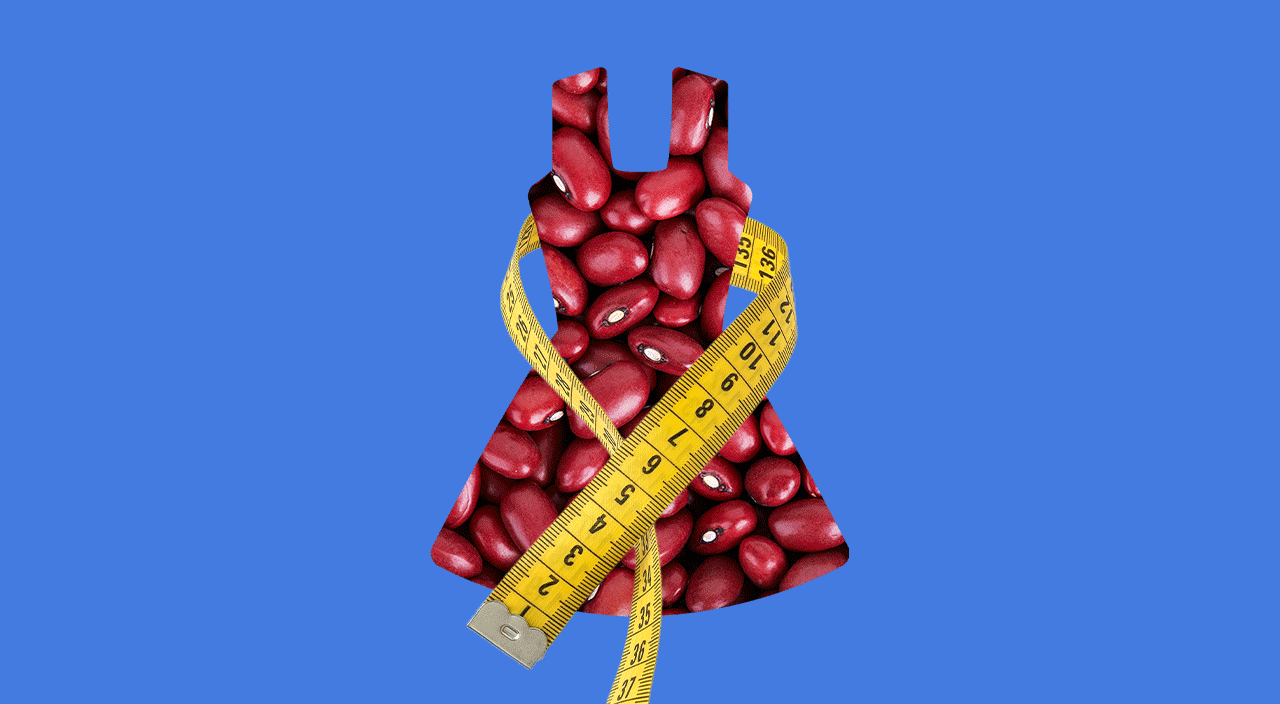What is your favorite way to cook and eat beans? Share your thoughts in the comments below.
Many of us remember a childhood story about a boy who planted magic beans that took him to a strange new world in the sky. In reality, beans’ magic has nothing to do with mythical giants, but they do have health superpowers that are nothing short of amazing. A 2024 study published in Nutrition Journal found that people who ate two servings of beans per day had lower body mass index, decreased body weight and improved waist circumference versus study subjects who did not consume beans. If shedding weight is among your wellness goals, you might be wondering what to eat to stay full and satisfied without going over your calorie and fat limits. Wonder no more: Beans may be your best friends.
Two servings a day to chase belly fat away
Beans could help you drop one or more dress sizes over time because they give you both protein and fiber in one low-calorie and low-fat package. This combination helps you feel full longer, confirms heart.org. According to Web MD, "Adding beans to your diet helps cut calories without feeling deprived.”
A 2024 study published in Nutrition Journal found that people who ate two servings of beans per day had lower body mass index, decreased body weight and improved waist circumference
Beans contain obesity-fighting and blood-pressure friendly isoflavones. These plant compounds that act like estrogen can help you balance your hormones, reduce your hunger, and prevent fat storage, according to Healthline. Soy isoflavones, in particular, have been found to protect against metabolic syndrome, according to a 2021 article in the journal Molecules. One characteristic of this syndrome is a large belly. Soy isoflavones are also protective against blood sugar spikes, against menopause symptoms such as hot flashes and night sweats, and against diabetes.
Clobber cravings and close the gap on nutrient deficiencies
Did you know that beans are also full of hard-to-get nutrients? The Nutrition Journal study found that “Bean consumers also had significantly higher intakes of several shortfall nutrients (choline, alpha-linolenic acid, folate, iron, magnesium and vitamin E) relative to non-consumers of beans. Similarly, intake of dietary fiber, potassium and calcium, all nutrients of public health concern were significantly higher in bean [eating] patterns compared to no-beans.”
During a 10-year analysis of over 15,000 Americans, those who regularly ate beans were the least likely to experience weight gain or belly bulge.
Which are the best beans for weight loss?
All beans can be helpful for weight loss when prepared healthfully, but some beans have special advantages that make them stand out. We’ve already shared why soybeans (often enjoyed as tofu and edamame) are truly a weight-loss winner. Other good options are fiber-rich black beans, iron-packed kidney beans, high-protein chickpeas and quick-cooking lentils. Beans may also help you keep the weight off in the long term. A 2023 study in the journal Nutrients found that during a 10-year analysis of over 15,000 Americans, those who regularly ate beans were the least likely to experience weight gain or belly bulge.
4 beans that don’t work for waist-watchers
The first one is obvious: Jellybeans! These sugar bombs may be shaped like legumes, but the similarities end there. Beyond that, some ways of preparing beans can make them less healthy. Pork and beans may have added sugar, added high fructose corn syrup and added saturated fat. Baked beans are traditionally stewed in brown sugar or molasses. And refried beans are traditionally cooked with lard (animal fat) or vegetable oil. They may also contain added sugar.
What to do about gas
If you don’t eat beans regularly, consider adding just one or two half-cup servings per week to start, giving your digestive system time to adjust. Speak with your health care provider about which dietary changes are right for you. Also:
- Rinse canned beans before eating, suggests mindbodygreen.com. This gets rid of some of the gassy oligosaccharides—sugars that gut bacteria ferment into, well, farts.
- Consider a probiotic supplement. These can help add good bacteria and inhibit the growth of bad bacteria in the digestive tract, according to WebMD.
- Consider an enzyme supplement such as Beano, Bean-zyme, Enzymedica Bean Assist or Global Healing Ultimate Enzymes. These help the body digest the sugars linked to flatulence.
- Soak beans overnight, then rinse before cooking. This draws out some of the offending sugars, which are then discarded, according to mindbodygreen.
- Prepare beans using a pressure cooker or multicooker, which accomplishes the same thing.
- Try a different variety of bean. A 2011 review of three studies found that black-eyed peas caused fewer issues with gas than pinto beans and vegetarian baked beans. A food diary can help you decide which beans work for you.
- Be patient. The same review found that subjects’ systems adjusted to the beans, and they became less gassy after 8 weeks.
If you don’t eat beans regularly, consider adding just one or two half-cup servings during the week to start, giving your digestive system time to adjust.
These bean recipes are anything but boring
Beans are delicious in salads, soups, dips, veggie burgers, burritos, and casseroles. Try these recipes:
Cowboy Caviar
Is this a salsa, a side dish, a salad or a dip? Who cares! It’s delicious! This version feeds a crowd (as a dip with tortilla chips) and refrigerates well. If you plan to serve and use it up right away, try adding cubed avocado.
Serves 16
Ingredients
1 15-oz can low-sodium kidney beans (drained and rinsed)
1 15-oz can low-sodium black beans (drained and rinsed)
1 15-oz can yellow corn (drained)
1 15-oz can crushed tomatoes (drained)
1 4-oz can chopped green chiles
1 Tbsp avocado oil or canola oil
3 oz. lime juice (juice of 3 medium limes)
Salt to taste
black pepper to taste
hot sauce to taste
Method
- Mix kidney beans, black beans, corn, tomatoes, chilies, and onion in a large bowl.
- Add lime juice and oil, toss gently to combine. Taste. Add small amount of salt and pepper or hot sauce if desired.
Adapted from USDA MyPlate
Indian Spiced Lentils With Orzo Pasta
If you’ve enjoyed traditional dal served at an Indian restaurant, you’ll love those flavors re-mixed as a one-pot pasta meal. Dry lentils don’t need a soak before cooking, making them a time-saver.
Serves 6
Ingredients
1 Tbsp vegetable oil
1 large onion (chopped)
2 cloves garlic (finely chopped or 1/2 teaspoon garlic powder)
3 cups water
1 15-oz can diced tomatoes (with juice)
1/2 cup dry lentils (sorted and rinsed)
1 tsp ground cumin
1 tsp ground turmeric
1/4 tsp red pepper flakes
1/2 cup orzo
1/4 cup fresh cilantro (stems removed, chopped)
1 lime, cut into wedges, for garnish
Method
- Heat oil in a large skillet over medium heat. Add onion and garlic and cook 3 to 4 minutes.
- Stir in water, diced tomatoes with juice, lentils, cumin, turmeric, and red pepper flakes, if desired.
- Bring to a boil. Cover and reduce heat to low. Simmer for 25 minutes.
- Add pasta and cook uncovered until pasta is tender, about 10 minutes.
- Sprinkle with cilantro and serve warm with a wedge of lime.
Adapted from MedlinePlus
White Bean Hummus
You can serve this with bite-sized raw or blanched veggies such as bell pepper, carrot, celery, broccoli, zucchini, green beans and sugar snap peas. It’s also great as a dip for pita chips and as a sandwich spread.
Serves 6
Ingredients
1/2 cup extra virgin olive oil
2 Tbsp coarsely chopped garlic (about 6 cloves)
2 15.8-oz cans white cannellini beans or navy beans, rinsed and drained
1/4 cup freshly squeezed lemon juice
1 tsp ground cumin
2 Tbsp finely chopped fresh parsley
1/2 Tbsp sea salt
½ tsp cayenne pepper, optional
½ tsp smoked paprika, optional
Method
1. To infuse oil: In a small saucepan, combine the olive oil and garlic over medium-low heat until the garlic deepens to a very light brown. Remove from heat, let cool and strain through a fine mesh sieve, reserving both the oil and the garlic.
2. Place the cannellini or navy beans in a food processor or blender. Add the garlic, lemon juice, cumin, and parsley. Add salt, cayenne and paprika, if using. Process until smooth. Slowly pour in the reserved olive oil while the food processor or blender is running and process until light and smooth. Garnish with a sprinkle of paprika before serving.
What is your favorite way to cook and eat beans? Share your thoughts in the comments below.










